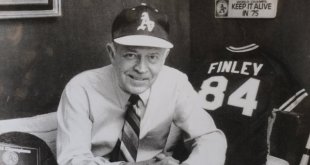Long before Sam Hinkie asked Philadelphia 76ers fans to trust the process, there was Charlie Finley. Long before Roger Goodell became known as the most notorious commissioner in professional sports, there was Bowie Kuhn. One of the most famous sports law cases[i] in history saw these two face off in a battle of egos that would impact the world of sports in a way that resonates today.[ii]
The Background
In 1920, in the wake of the infamous Black Sox scandal and cries of corruption, baseball granted vast power to its first commissioner: Kenesaw Mountain Landis, a former federal judge. When agreeing to serve as Commissioner of Baseball, he bargained for complete authority to make decisions, even obtaining a loyalty oath from owners. He had authority to “investigate any practice not in the best interest in baseball.” He also had prerogative to approve or deny any assignment of players. Baseball’s teams even waived “such right of recourse to the courts as would otherwise have existed in their favor.” The teams’ waiver of their right to sue was removed when Landis died, but was reinstated in 1964 when Bowie Kuhn was named commissioner. Kuhn, the fifth commissioner in baseball’s history, was “a compromise candidate selected after nineteen acrimonious ballots.”[iii]
The year was 1976. Charlie Finley was the owner of the dominant Oakland A’s, which had won three straight World Series from 1972-1974 and went to the ALCS in 1975. Just the year before, in 1975, arbitrator Peter Seitz had ruled that Andy Messersmith and Dave McNally were free agents because they did not have contracts. Fearing the increasing power of free agent players, owners locked out the players, eventually requiring them to play six years in the majors before becoming free agents.
The day was June 15, 1976. The trade deadline had come, and the Oakland A’s were about to shake up the world of baseball. The day of the deadline, the superpower A’s were a disappointing 27-31. Finley had already begun rebuilding his team, fearing that players would leave in free agency. He had traded Reggie Jackson and Ken Holtzman to Baltimore just before the start of the season. Now, at the trade deadline, he wanted to sell Joe Rudi and Rollie Fingers to the Red Sox and Vida Blue to the Yankees in exchange for cash.
Finley rationalized the trades by arguing that selling players for cash would allow the team the ability to invest in younger prospects who could help the team down the road. If he did nothing, he would get nothing when his players walked in free agency. While many modern professional teams might view variations of this argument as standard orthodoxy (get something for the player before he walks), it was not a popular, widespread idea at the time. But Finley was an innovator, so it’s no surprise he was thinking of creative ways to help his team win.
Commissioner Kuhn didn’t see it that way. He denied the trade, arguing that it made the A’s worse and created a loss of competitive balance. From Kuhn’s perspective, the whole idea of “selling” players was a bit too unsavory. Finley was even involved in a bidding war for Vida Blue, with the Tigers initially in for $1 million before being outbid by the Yankees for $1.5 million. In fact, this may have been the trade that broke the camel’s back, with Tigers owner John Fetzer having Kuhn’s ear.
It shouldn’t be overlooked that Kuhn and Finley had a history. During one World Series, Kuhn forced Finley to reinstate one of his own players after Finley had attempted to sideline him for “injury” after committing errors in extra innings of Game 2. In 1975, Finley had tried to replace Kuhn as commissioner. It’s hard to imagine Kuhn would have reacted similarly toward other owners with whom he had better relationships, as similar exchanges of players for cash had been approved in the past.
The Case
As those in sports law know, baseball, money, and litigation go together. So Finley sued.
The trial began on December 16, 1976. The primary issue of the case, as the Seventh Circuit would later put it, was “whether the Commissioner of baseball is contractually authorized to disapprove player assignments which he finds to be ‘not in the best interests of baseball’ where neither moral turpitude nor violation of a Major League Rule is involved.” At the time, MLB rules stated that no assignment of players would be valid unless approved by the commissioner.
In 1977, Judge Frank McGarr’s opinion sided with Kuhn and his words are still used in commissioner power lawsuits to this day:
“The case is not a Finley-Kuhn popularity contest. Neither is it an appellate judicial review of the wisdom of Bowie Kuhn’s actions. The question before the court is not whether Bowie Kuhn was wise to do what he did, but whether he had the authority.”
After Finley appealed, the case went to the Seventh Circuit Court of Appeals, which affirmed Judge McGarr’s ruling in 1978. Finley argued that the trade was beyond the scope of the Commissioner’s authority and that the denial of the trade was arbitrary and capricious.
The court initially reviewed the history of the role of the commissioner and the position’s power, noting that when “an attempt was made to place limitations on the Commissioner’s authority[,] Judge Landis responded by refusing to accept the office of Commissioner.” The basis for the commissioner’s authority derived from the Major League Agreement, a contract between MLB clubs. In a precursor to the language of today’s collective bargaining agreements, the Major League Agreement gave the Commissioner the role of investigating any acts “not in the best interests of the national game of Baseball” and to determine appropriate punishment. The Seventh Circuit interpreted that language to mean that:
“The Commissioner has been given broad power in unambiguous language to investigate any act, transaction or practice not in the best interest of baseball….He has also been given the express power to approve or disapprove the assignments of players.”
Although Finley argued the trade should be allowed because his business would suffer, the court found that the commissioner is contractually authorized to disapprove player assignments that he considers not in the best interest of baseball. The agreement had no limitation on the commissioner’s authority in this regard.
Finley argued that he did not have notice of this exercise of authority because the decision was not in line with past precedent. The court stated, however, that the historical circumstances and express language of the agreement provided the commissioner with the authority to disapprove the transaction at issue. Previous commissioners with similar powers had acted similarly, and Kuhn had done so as well. The court also found that baseball is distinct from other corporate structures and does not require the same procedurally consistent decisions. Whether the commissioner was right or wrong was not within the court’s jurisdiction.
The court further held that the “waiver of recourse” provision was intended to insulate such decisions from judicial review and that the clause was enforceable, except where the rules contravene the law or the bylaws of the organization and in situations when the organization has failed to follow the basic rudiments of due process of law.
The Impact
After all that, Finley did lose players to free agency after that season. He tried to sell another player to the Rangers, and Kuhn again tried to make life difficult by delaying the trade. Finley again tried to trade Blue, but Kuhn stopped him by claiming the trade was bad for the A’s.[iv] Imagine if modern commissioners blocked trades because they thought they would be bad for teams….[v]
But the case and its impact would live on. Commissioner power affects almost every disciplinary case in today’s major sports leagues. The source and scope of a commissioner’s power matter. And sports league commissioners still have broad power to deal with practices not in the best interest of their sports.
Commissioners today have a number of roles. At the most basic level, their job is to ensure the continuation of the sport and to assess the best way to accomplish that. Commissioners must foster competition not only on the field, but financially – among fans, cities, players, and coaches. Commissioners must also foster cooperation among teams, to ensure the future of the league and competitive balance.
But significantly, the commissioner also acts as the CEO, in the interest of the team owners. The commissioner’s power may seem unfettered in a CBA, but it is only “apparently” unfettered. A commissioner’s authority is exclusively a function of team owners’ preferences. If enough owners disapprove of the commissioner’s exercise of his power, they could decide to replace him or restrict his powers. Despite this “check” it is becoming increasingly difficult to exercise as owners become more focused on revenue and sports revenues continue to climb.
Generally, commissioners may not act arbitrarily or capriciously, and they may not violate the rules of their own league, just as the court in Finley laid out. But what constitutes a capricious action or a violation of the rules is up for interpretation. And because of the broad deference courts give to commissioners’ powers, they are less likely to interpret commissioners as crossing those lines. In a normal employment context, perhaps courts would see things differently. But players associations have continued to grant commissioners these broad powers under their respective collective bargaining agreements. And with those broad powers comes broad deference to commissioner power, even when that power ostensibly ignores the rules of the sport’s own CBA.
The influence of Finley v. Kuhn reverberates today. Whether it’s NBA Commissioner Adam Silver’s attempt to rein in a recalcitrant owner like Donald Sterling, or NFL Commissioner Roger Goodell’s reliance on his “conduct detrimental” power to punish Tom Brady, courts have defended the extensive power of league commissioners for a half century and will continue to do so for the foreseeable future.
[i] Charles O. Finley & Co., Inc. v. Kuhn, 569 F.2d 527 (7th Cir.1978).
[ii] In our Sports Law History series, The Sports Esquires will occasionally examine a significant case in sports law history and discuss how it influences the way we view and play sports today.
[iii] Cozzillio, Levinstein, Dimino, and Feldman, Sports Law: Cases and Materials, 59 (2d ed. 2007).
[iv] It wasn’t until two years after the initial trade that he was able to finally ditch Blue, getting back seven players and $390,000 in return (just under the $400,000 threshold that Kuhn had stated was the amount requiring his approval). Meanwhile, the A’s kept getting worse, and Finley eventually sold the team in 1980 to Walter Haas.
 The Sports Esquires Putting Sports on Trial
The Sports Esquires Putting Sports on Trial





One comment
Pingback: Sports Law Links - The Sports Esquires